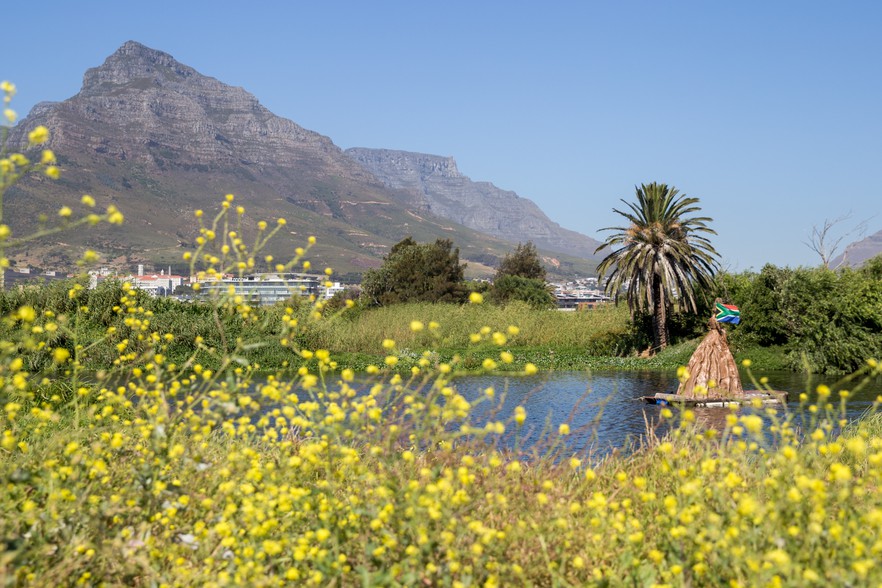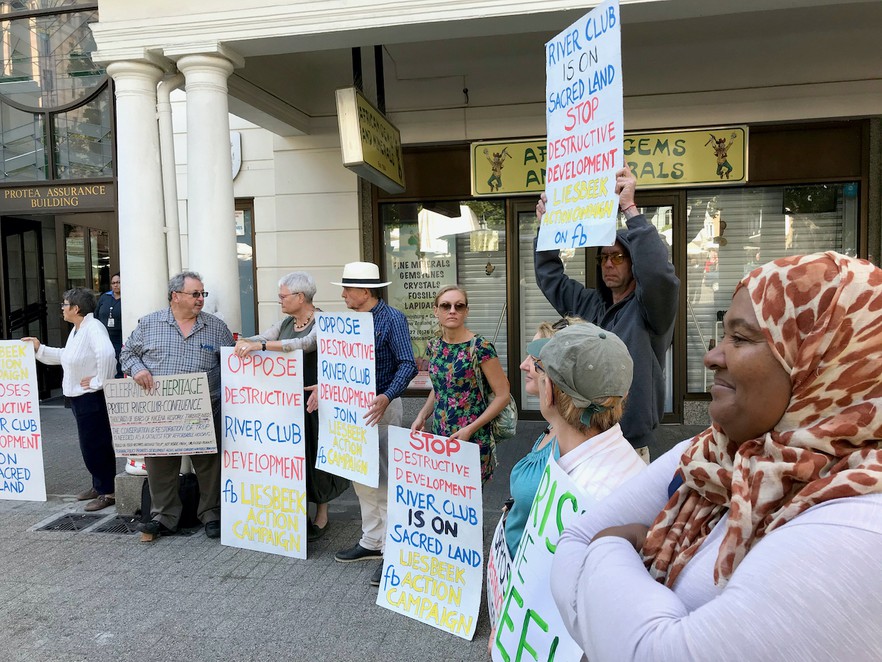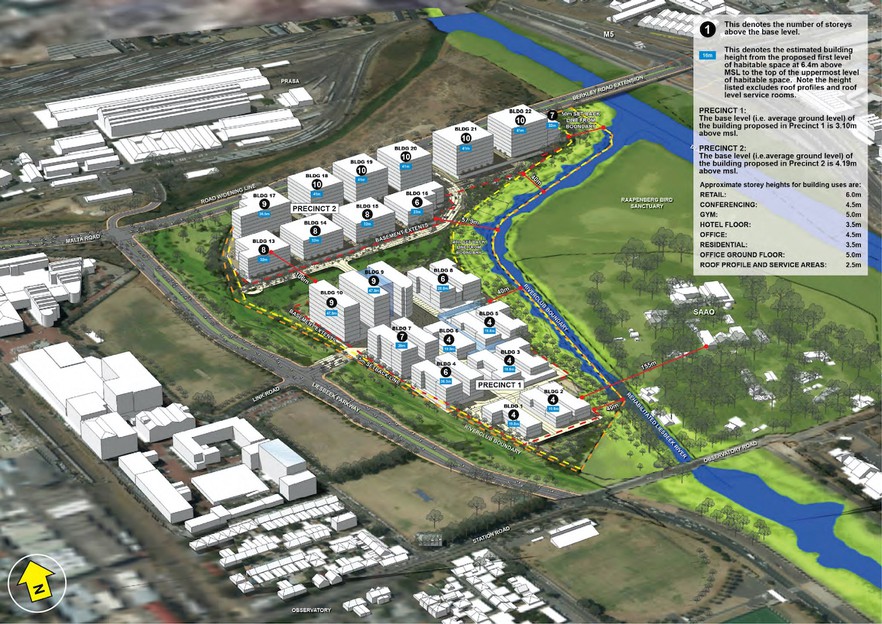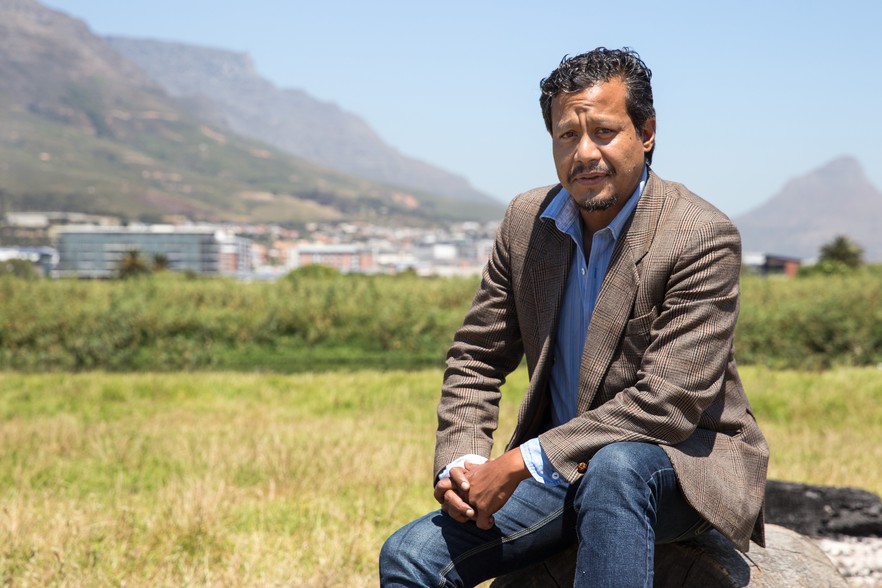Fierce battle over future of landmark Cape Town site
Developers and government manoeuvre to realise ten-storey buildings at River Club, while Khoi organisations fight for land they say is sacred
It was apparent during a provincial heritage appeal tribunal hearing, dealing with a proposed massive development at the River Club in Observatory, that the City of Cape Town and the Western Cape government are being led in the matter by a private developer.
Liesbeek Leisure Property Trust is appellant number one in the appeal against an existing two-year heritage protection order, invoked to provide Heritage Western Cape the opportunity to investigate formal protection of the land. Appellants two to four are the provincial Department of Environmental Affairs and Development Planning, provincial Department of Transport and Public Works, and the City of Cape Town.
However, their reasons for appealing the provisional protection order remained unheard at the tribunal hearing on 21 November, as the day was spent hearing their arguments for a postponement of the hearing of their own appeal.
Civic organisations and traditional bodies are opposing the proposed construction of ten-storey buildings and 11.7ha of building in the middle of what all parties agree is a sacred site for First Nation peoples.
The reasons for seeking a postponement, according to Liesbeek Leisure Property Trust legal representative Nicholas Smith and the Department of Transport and Public Works acting Two Rivers Urban Park programme manager, Gerhard Gerber, are that Heritage Western Cape had not met the tribunal’s January directive to meaningfully engage with the appellants and interested and affected parties in an effort to reach common ground.
Smith and Gerber both stated during the postponement hearings, that common ground did not exist, or was, according to Smith “unlikely to be found”.
The appellants are in favour of development. The interested parties, with one unexpected exception, oppose development on the site.
A nine-hole Mashie golf course currently exists on the River Club land, as well as a conference centre, pub and other amenities, which were operated on a long term lease dating back to at least 2008, between original property owners Transnet and what was Liesbeek Leisure (Pty) Ltd.
Liesbeek Leisure was reconstituted as Liesbeek Leisure Properties Trust and it purchased the 14.8ha of land from Transnet for R12 million excluding VAT in 2015. The land was purchased in full knowledge that the site is on a flood plain and zoned as Open Space with conservation status.
Interested and affected parties protest against development at the River Club prior to the Heritage Appeals Tribunal hearing of 21 November held at the offices of Heritage Western Cape. Photo: Steve Kretzmann
First Nations divided
After tribunal chair Ashraf Mohammed gave two-and-a-half hours to the appellants’ arguments for postponement of their own appeal, the interested parties were given the opportunity to voice their opposition.
The interested and affected parties were: Two Rivers Urban Park Association, Observatory Civic Association, Kai Bi’a Hennie van Wyk, representing various First Nation houses, Goringhaicona Khoi Khoin Indigenous Traditional Council, and the Gorinhaiqua and Griqua traditional councils.
Kai Bi’a of the Gorachouqua, through his spokesperson Zenzile Khoisan, supported the motion to postpone the hearing of the appeal against the provisional two-year protection order.
Khoisan said they believed it “necessary for us not to place ourselves unnecessarily under the tyranny of the clock”.
There had not been sufficient meaningful interaction with the First Nations, said Khoisan. “We want to, in a consolidated way, apply our minds to the proposal,” he said.
This was a surprise to Tauriq Jenkins, Supreme High Commissioner for the Goringhaicona Khoi Khoin Traditional Indigenous Council under Paramount Chief Aran.
There “seems to be a difference of opinion as far as the notion of public consultation is concerned” said Jenkins after the weekend.
Advocate Winston Erasmus, representing the Gorinhaiqua and Griqua traditional councils, also appeared to be taken aback by Khoisan’s support for the postponement, and argued the lack of historic meaningful engagement with the First Nations was why Heritage Western Cape should be allowed the opportunity to thoroughly investigate whether the site should be granted formal protection.
Jenkins, via email, stated: “It seems both strange and inexplicable to see the extraordinary attempts to delay the impending voice that will simply say: “This is our beautiful and sacred heritage, please go ahead and protect it.”
“They seem perhaps to fear the deepening understanding of ourselves as a nation, and want to withhold being witness to a single moment of truth when we will utter from the depths of our humanity that this is a place of Ground Zero, of where it all happened. A space where we as Africans can recognise our collective restoration from a brutal past. A place that holds the Khoi soul.”
A First Nations Report commissioned by the province, although having the shortcoming of not attributing quotes to specific First Nation interviewees, unequivocally reveals the historic and continued significance of the confluence of the Liesbeek and Black Rivers.
It was the epicentre of the first resistance against colonialism, where the Gorinhaiqua fought and killed Portuguese Viceroy Francisco D’ Almeida in 1510, only to later see it become the first land usurped by colonial powers and become a frontier of displacement which was four centuries later codified into law through apartheid. It is also a sacred site of remembrance and heralding the ancestors.
Now the Liesbeek Leisure Property Trust seeks to fill in the floodplain, build a bridge extending Berkley Road in Ndabeni across the Black River to Liesbeek Parkway, and construct 20 buildings, five of them ten-storeys (47 metres high), as well as provide parking, walkways and landscaping.
Most of the 150,000m² of floorspace proposed in the Basic Assessment Report, compiled by SRK Consulting, will be given to commercial office space (53%), followed by residential (20%), ancillary amenities such as a gym and hotel (16%), and retail (10.6%).
An impression of the proposed River Club development contained in the Basic Assessment Report, a public document produced by SRK Consulting
Shifting the goalposts
The Two Rivers Urban Park was established following a series of workshops with the various landowners between 2003 and 2009. It was then declared a “green space” in terms of the 2030 Spatial Development Framework for the City.
The spatial plan identifies the River Club site within the Two Rivers Urban Park as a “Conservation Area” where residential and commercial development, among other land uses, were declared undesirable, according to Two Rivers Urban Park Association chair Marc Turok.
Turok said building on the River Club could be likened to wanting to build on Table Mountain, or Signal Hill, with the additional element of historical heritage going back prior to settlement by the Dutch.
In the same year the land was transferred to the Liesbeek Leisure Property Trust, the City appointed Nisa Mammon and Associates as consultants in what appears to have been an attempt to backtrack and enable development on the site.
According to the draft Two Rivers Local Spatial Development Framework produced on behalf of the City of Cape Town and provincial Department of Transport and Public Works, released in October, Nisa Mammon and Associates were “to update the previous work done to align with the new City of Cape Town Planning Bylaw, 2015” and to develop “the plan from a Contextual Framework to a Development Framework in terms of the package of plans approach”.
But Mammon and Associates did not provide the desired results, says Turok. “She [Nisa Mammon] was squeezed [by the City and Province] to the point where she said she’s not going to carry on,” said Turok.
“The impression was that she did a good job and had to walk away,” he said, as the results were “too restrictive to the developer”.
The new draft Two Rivers Local Spatial Development Framework states Mammon’s plan “was incomplete and was not advertised for public comment”.
Crispian Olver, in his book A House Divided, which examines the City of Cape Town administration based on research for his PhD, wrote: “The planners working on the spatial strategy for the Two Rivers Urban Park … came under significant pressure – from both the City and provincial authorities – to amend their technical reports, which advised against the project as it was conceived, on the grounds that it was located on a floodplain, which also happened to be of great historical significance. When they refused, their contracts were not renewed and the plan was put on hold.”
Mammon was not available for comment. Questions sent via email received an out-of-office reply, stating she would be unavailable until 3 December.
Following Mammon’s departure, the Two Rivers Urban Park was extended to include Ndabeni on the east of the Black River, said Turok.
A new team of consultants led by ARG Design was hired by the City under Mayor Patricia De Lille in 2018. The new draft framework provides a positive assessment for the development.
Khoi Khoin representative Tauriq Jenkins surveys the site where a massive commercial, residential, and retail development, comprising buildings up to ten-storeys high, is proposed on the River Club site in Observatory. The site is ground zero for the first displacement of indigenous people. Photo: Ashraf Hendricks
Turok believes the appeal, and the further move to postpone the appeal against the provisional protection order despite it ending in five months, is a cynical ploy to tie up Heritage Western Cape in paperwork and hamper their ability to investigate formal protection of the site.
Section 29 of the National Heritage Resources Act, which deals with provisional protection, states: “[n]o person may… subdivide or change the planning status of a provisionally protected place”.
The Two Rivers Local Spatial Development Framework has been compiled during the period of the provisional protection which was gazetted in April 2018. The new Two Rivers Local Spatial Development Framework seeks to change the area’s planning status, and two open days – 23 October and 20 November – have been held for public comment.
The Act would only be violated if the Two Rivers Local Spatial Development Framework is signed off before the end of the provisional protection, said Turok, but the fact that the authorities have appointed SRK Consulting to develop the new Two Rivers Local Spatial Development Framework before the grading is determined, reveals their intentions.
Heritage Western Cape CEO Mxolisi Dlamuka said the appeal did result “in additional tasks” for the organisation, but had not impacted its capacity to investigate the site.
Dlamuka said Heritage Western Cape was “not adequately capacitated” but was able to function fully and implement its mandates.
Liesbeek Leisure Property Trust spokesperson Trace Venter denied the trust was cynically tying up Heritage Western Cape’s work, claiming it was Heritage Western Cape who persisted in a “dual process” of invoking the provisional protection even though “comprehensive heritage impact assessments were being undertaken” by independent heritage experts as required for any development of the size proposed.
“The Liesbeek Leisure Property Trust,” said Venter, “represented in particular by Mr Jody Aufrichtig, had a number of meetings with First Nations representatives over the past three years, over and above the required public participation processes prescribed by legislation.”
She said the trust wished to memorialise the historical significance of the area.
The tribunal agreed to the postponement, with further engagement required by Heritage Western Cape. The appeal hearing was scheduled for 6 and 7 February next year, just two months before the provisional protection order ends.
Support independent journalism
Donate using Payfast

Don't miss out on the latest news
We respect your privacy, and promise we won't spam you.
Letters
Dear Editor
The proposed River Club development is in the same flood plain that is shared by Lower Observatory and our highways.
This means that flood waters which once used to flood in the RIver Club wetland will be diverted by the massive infilling. With global warming and extreme weather this seems like we are dooming Observatory to more frequent and severe flooding events.
This risk of flooding occurs every year but we last had this recently in 2019 and before that in 2013. The river club developers need a return on investment within just a few years, while generations to come will actually have to live with the short sighted vision to infill a vital floodplain which is close to N1 and N2. The developers own biased hydrology report states that flood levels will only increase by a maximum of 15cm.
What level rise would be considered not safe in our global warming weather uncertainty scenario?
© 2019 GroundUp.
This article is licensed under a Creative Commons Attribution-NoDerivatives 4.0 International License.
You may republish this article, so long as you credit the authors and GroundUp, and do not change the text. Please include a link back to the original article.




